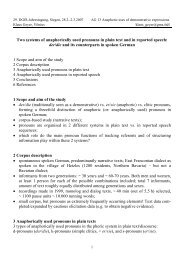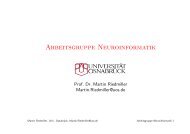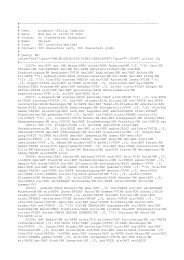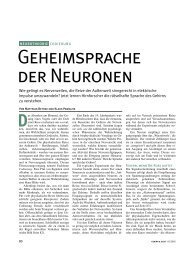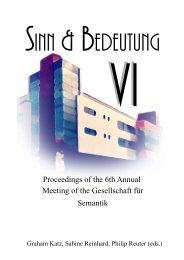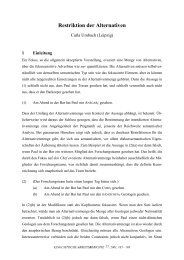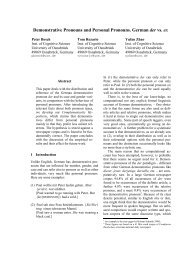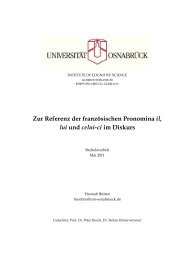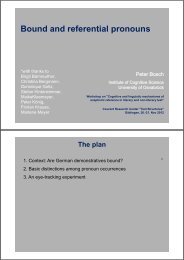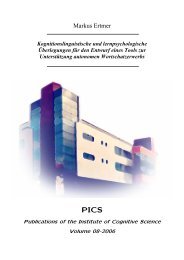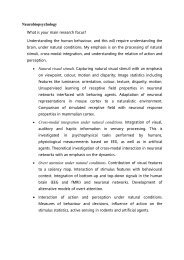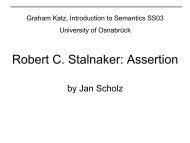Eye-Tracking Evidence for the Reference of German Demonstratives
Eye-Tracking Evidence for the Reference of German Demonstratives
Eye-Tracking Evidence for the Reference of German Demonstratives
You also want an ePaper? Increase the reach of your titles
YUMPU automatically turns print PDFs into web optimized ePapers that Google loves.
<strong>Eye</strong>-<strong>Tracking</strong> <strong>Evidence</strong> <strong>for</strong> <strong>the</strong> <strong>Reference</strong> <strong>of</strong> <strong>German</strong> <strong>Demonstratives</strong><br />
Fachbereich Humanwissenschaften,<br />
Institut für Kognitionswissenschaft<br />
<strong>Eye</strong>-<strong>Tracking</strong> <strong>Evidence</strong> <strong>for</strong> <strong>the</strong> <strong>Reference</strong> <strong>of</strong><br />
<strong>German</strong> <strong>Demonstratives</strong><br />
Bachelor Thesis<br />
August 2010<br />
Sebastian Timmer (setimmer@uos.de)<br />
Supervisors: Pr<strong>of</strong>. Dr. Peter Bosch (pbosch@uos.de)<br />
Pr<strong>of</strong>. Dr. Peter König (pkoenig@uos.de)<br />
1
Abstract<br />
<strong>Eye</strong>-<strong>Tracking</strong> <strong>Evidence</strong> <strong>for</strong> <strong>the</strong> <strong>Reference</strong> <strong>of</strong> <strong>German</strong> <strong>Demonstratives</strong><br />
This study was conducted in order to find out whe<strong>the</strong>r it is possible that a referent in discourse<br />
topic is accessible to demonstrative pronouns in discourses with two grammatically possible<br />
antecedents. This is contrary to what <strong>for</strong>mer studies found out. But our hypo<strong>the</strong>sis that this<br />
works anyway, is based on an example with only one possible antecedent that is very natural<br />
and intuitive in <strong>German</strong> everyday language use. We tried to convert this example into a<br />
discourse with two referents. The experiment was done with eye-tracking and participants had<br />
to look at sceneries built with Playmobil while listening to <strong>the</strong> sentences we wanted to<br />
investigate. The results did not support <strong>the</strong> hypo<strong>the</strong>sis, as in all conditions <strong>the</strong> referent in<br />
focus position was fixated significantly more.<br />
2
Contents<br />
<strong>Eye</strong>-<strong>Tracking</strong> <strong>Evidence</strong> <strong>for</strong> <strong>the</strong> <strong>Reference</strong> <strong>of</strong> <strong>German</strong> <strong>Demonstratives</strong><br />
1 INTRODUCTION ..................................................................................................... 4<br />
2 METHODS............................................................................................................... 8<br />
2.1 Stimuli .............................................................................................................................8<br />
2.1.1 Visual Stimuli............................................................................................................8<br />
2.1.2 Auditory Stimuli ........................................................................................................9<br />
2.2 Randomization/Balancing ............................................................................................11<br />
2.3 Participants...................................................................................................................11<br />
2.4 Apparatus......................................................................................................................12<br />
2.5 Procedure ......................................................................................................................12<br />
2.6 Data Analysis ................................................................................................................13<br />
2.6.1 Fixations ..................................................................................................................13<br />
2.6.2 Statistics ..................................................................................................................14<br />
2.6.3 Regions <strong>of</strong> Interest ...................................................................................................14<br />
3 RESULTS.............................................................................................................. 15<br />
4 DISCUSSION ........................................................................................................ 23<br />
5 CONCLUSION ...................................................................................................... 24<br />
6 REFERENCES ...................................................................................................... 25<br />
7 ACKNOWLEDGMENT .......................................................................................... 27<br />
8 APPENDIX ............................................................................................................ 28<br />
A Visual Stimuli..................................................................................................................28<br />
B Auditory Stimuli .............................................................................................................32<br />
C Questionnaire and Data Sheet........................................................................................42<br />
C.1 Subject Questionnaire.................................................................................................42<br />
C.2 Session Data Sheet .....................................................................................................45<br />
9 AFFIRMATION...................................................................................................... 46<br />
3
1 Introduction<br />
<strong>Eye</strong>-<strong>Tracking</strong> <strong>Evidence</strong> <strong>for</strong> <strong>the</strong> <strong>Reference</strong> <strong>of</strong> <strong>German</strong> <strong>Demonstratives</strong><br />
The comprehension <strong>of</strong> pronominal expressions is a task in everyday language that does not<br />
lead to problems to understand to what antecedent <strong>the</strong> pronoun refers to. Although <strong>the</strong><br />
mechanism behind that seems to be complex. The linguistic function <strong>of</strong> pronouns is to<br />
substitute a noun phrase in order to avoid <strong>the</strong> repetition <strong>of</strong> explicit names. Thus, <strong>the</strong>y are pro-<br />
<strong>for</strong>ms used to refer back to a concept that has been introduced in <strong>the</strong> discourse be<strong>for</strong>e [Almor<br />
et al., 2007]. They are anaphoric expressions and <strong>the</strong>re<strong>for</strong>e coreferential with <strong>the</strong>ir antecedent<br />
<strong>the</strong>y replace. So <strong>the</strong> main task is to find <strong>the</strong> correct antecedent, especially in cases in which<br />
<strong>the</strong>re is more than one possible candidate. This process is called <strong>the</strong> anaphora resolution. The<br />
resolution process consists, according to Nicol and Swinney (1999), <strong>of</strong> three steps. The first<br />
step is <strong>the</strong> denomination <strong>of</strong> <strong>the</strong> pronoun triggering <strong>the</strong> search <strong>for</strong> an antecedent. Then in a<br />
second step all potential antecedents are taken into account until finally in step tree exactly<br />
one candidate <strong>of</strong> <strong>the</strong> whole set is picked up and all o<strong>the</strong>rs get discarded. We are only aware <strong>of</strong><br />
<strong>the</strong> last step while <strong>the</strong> o<strong>the</strong>r two remain unconscious [Nicol and Swinney, 2002]. Most <strong>of</strong> <strong>the</strong><br />
time it does not cause problems to pick <strong>the</strong> right candidate and it can be easily per<strong>for</strong>med,<br />
although we do not pay attention to it. This is <strong>the</strong> case <strong>for</strong> <strong>the</strong> simple example (1) below:<br />
Example (1):<br />
Ein Mann geht nach hause. Er war bis gerade im Büro.<br />
(A man is going home. He was in <strong>the</strong> <strong>of</strong>fice until now.)<br />
One <strong>of</strong> <strong>the</strong> most important works concerning <strong>the</strong> topic <strong>of</strong> reference <strong>of</strong> anaphoric expressions<br />
is Binding Theory [Chomsky, 1981], that deals with syntactic restrictions. Chomsky<br />
differentiates between three kinds <strong>of</strong> anaphoric expressions, which are Anaphors (bound<br />
pronouns like “himself”), Pronominals (referential pronouns like “he”) and R-expressions<br />
(like “<strong>the</strong> policeman”). Referential pronouns are not allowed to be bound (c-commanded) by<br />
<strong>the</strong>ir antecedents.<br />
Besides <strong>the</strong>se syntactic restrictions also semantic processes seem to play an important role in<br />
making <strong>the</strong> decision <strong>for</strong> one or <strong>the</strong> o<strong>the</strong>r referent as antecedent [Caplan and Hildebrandt,<br />
1988]. Discourse Representation Theory (DRT) [Kamp, 1981] and <strong>the</strong> Centering Theory<br />
[Grosz et al., 1995] are semantic approaches to this topic. Kamp’s idea is that <strong>the</strong> resolution <strong>of</strong><br />
a pronoun goes beyond sentence boundaries. Here every sentence has to be integrated<br />
stepwise into a discourse representation structure in which <strong>the</strong> right antecedent can be<br />
4
<strong>Eye</strong>-<strong>Tracking</strong> <strong>Evidence</strong> <strong>for</strong> <strong>the</strong> <strong>Reference</strong> <strong>of</strong> <strong>German</strong> <strong>Demonstratives</strong><br />
possibly found. The <strong>the</strong>ory <strong>of</strong> Grosz et al. deals with <strong>the</strong> saliency <strong>of</strong> referents to explain<br />
restrictions that may occur.<br />
Fur<strong>the</strong>r, it seems that pragmatic in<strong>for</strong>mation have to be taken into account dealing with <strong>the</strong><br />
topic <strong>of</strong> pronoun resolution [Bosch et al., 2007], additionally to <strong>the</strong> ones mentioned above.<br />
In <strong>German</strong> <strong>the</strong>re are two types <strong>of</strong> pronouns that can refer to given proper nouns. These are<br />
personal pronouns (PPros) like “er, sie, es” on <strong>the</strong> one hand and demonstrative pronouns<br />
(DPros) like “der, die, das” on <strong>the</strong> o<strong>the</strong>r hand. In a discourse with only one suitable referent<br />
both pronoun types can refer to that antecedent like in <strong>the</strong> Example (2).<br />
Example (2)<br />
Ein Mann geht nach hause. Er/Der war bis gerade im Büro.<br />
(A man is going home. He PPro/DPro was in <strong>the</strong> <strong>of</strong>fice until now.)<br />
But Bosch et al. found evidence <strong>for</strong> a grammatical distinction <strong>of</strong> personal and demonstrative<br />
pronouns [Bosch et al., 2007]. Personal pronouns have a preference <strong>for</strong> <strong>the</strong> noun phrase <strong>of</strong> <strong>the</strong><br />
preceding sentence in subject position, while demonstrative pronouns tend to prefer <strong>the</strong> noun<br />
phrase in non-subject position. The <strong>the</strong>ory get supported by <strong>the</strong> works <strong>of</strong> F. Krause (2007)<br />
and M. Meyer (2007). In <strong>the</strong> example (3) below this is shown, in which “er” would substitute<br />
<strong>the</strong> noun phrase “der Polizist” and “der” would point to “dem Aut<strong>of</strong>ahrer”. Unless <strong>the</strong> world<br />
knowledge pushes <strong>the</strong> interpretation <strong>of</strong> a pronoun into <strong>the</strong> one or <strong>the</strong> o<strong>the</strong>r direction <strong>the</strong> PPro<br />
and <strong>the</strong> DPro behave this way.<br />
Example (3)<br />
Der Polizist redet mit dem Aut<strong>of</strong>ahrer. [Er/Der] regt sich fürchterlich auf.<br />
(The policeman talks to <strong>the</strong> car driver. He PPro/DPro is very angry.)<br />
Similar observations were made <strong>for</strong> pronouns in Italian [Carminati, 2002], Finnish [Kaiser<br />
and Trueswell, 2005] and Dutch [Kaiser and Trueswell, 2007].<br />
What concerns this study is <strong>the</strong> fact that demonstrative pronouns prefer non-subject<br />
antecedents [Bosch and Umbach, 2007]. This is <strong>the</strong> noun phrase in focus position. As it is<br />
<strong>of</strong>ten noted, opposing to <strong>the</strong> open proposition, which is generally taken to be ‘old’<br />
in<strong>for</strong>mation, already in <strong>the</strong> discourse model or at least known or inferable, <strong>the</strong> focus is taken<br />
to be ‘new’ in<strong>for</strong>mation [Chomsky, 1971], [Prince, 1978], [Wilson and Sperber 1979], [Horn,<br />
1981], [Delahunty, 1982] and [Gundel, 1985]. In focus <strong>the</strong> referent is not only in short-term<br />
5
<strong>Eye</strong>-<strong>Tracking</strong> <strong>Evidence</strong> <strong>for</strong> <strong>the</strong> <strong>Reference</strong> <strong>of</strong> <strong>German</strong> <strong>Demonstratives</strong><br />
memory, but is also at <strong>the</strong> current center <strong>of</strong> attention [Gundel, Hedberg and Zacharski, 1993].<br />
Although demonstrative pronouns generally reject subject antecedents, <strong>the</strong>y may also accept<br />
<strong>the</strong>m, at least in non-competition situations, like in <strong>the</strong> Examples (4) and (5) <strong>of</strong> Bosch and<br />
Umbach (2007).<br />
Example (4)<br />
Example (5)<br />
Woher ichk das weiß? Peteri hat es mirk gesagt. Deri war gerade hier.<br />
(How do I know? Peteri told me. Hei (DPro) has just been here.)<br />
Woher Mariak das weiß? Peteri hat es ihrk gesagt. Deri war gerade hier.<br />
(How does Mariak know? Peteri told herk. Hei (DPro) has just been here.)<br />
Thus, <strong>the</strong> grammatical role <strong>of</strong> an antecedent may be a fair corpus generalization, but is<br />
definitely not <strong>the</strong> relevant parameter.<br />
Subjects typically refer to discourse topics and DPros normally avoid referents in discourse<br />
topic [Bosch and Umbach, 2007]. Topic and focus are categories <strong>of</strong> in<strong>for</strong>mation structure,<br />
which is a discourse property that is not always directly reflected in <strong>the</strong> syntax and <strong>the</strong><br />
semantics <strong>of</strong> sentences.<br />
Hans-Martin Gärtner came up with <strong>the</strong> following Example (6):<br />
Example (6)<br />
Gestern habe ich Karlk getr<strong>of</strong>fen. Erk arbeitet jetzt bei IBM.<br />
Denk sollten wir mal einladen.<br />
(Yesterday I met Karlk. Hek works <strong>for</strong> IBM now.<br />
We should invite himk (DPro) some time.)<br />
Karl in this example is a clear case <strong>of</strong> discourse topic: repeated previous reference, last<br />
reference by an unstressed anaphoric PPro. But still it is accessible to <strong>the</strong> DPro. In <strong>German</strong> it<br />
is even more natural to use <strong>the</strong> DPro in this case.<br />
The aim <strong>of</strong> this study now is to find out whe<strong>the</strong>r this example also works <strong>for</strong> sentences with<br />
more than one possible referent. What are <strong>the</strong> special aspects that make up this example?<br />
First <strong>of</strong> all <strong>the</strong> predicate in <strong>the</strong> third sentence here must be a characterizing one because<br />
6
o<strong>the</strong>rwise, as in Example (7), it does not work.<br />
Example (7)<br />
<strong>Eye</strong>-<strong>Tracking</strong> <strong>Evidence</strong> <strong>for</strong> <strong>the</strong> <strong>Reference</strong> <strong>of</strong> <strong>German</strong> <strong>Demonstratives</strong><br />
Gestern habe ich Karlk getr<strong>of</strong>fen. Erk arbeitet jetzt bei IBM.<br />
Derk hatte letzte Woche einen Autounfall.<br />
(Yesterday I met Karlk. Hek works <strong>for</strong> IBM now.<br />
Hek (DPro) had a car accident last week.)<br />
It seems that a familiarity to <strong>the</strong> person in discourse topic supports <strong>the</strong> intensity <strong>of</strong> <strong>the</strong> effect.<br />
While <strong>the</strong> o<strong>the</strong>r referent in focus serves more like an attribute to <strong>the</strong> one in subject position.<br />
There<strong>for</strong>e we introduce our first referent (R1) with a name (e.g. “Klempner Friedrich”) to<br />
minimize <strong>the</strong> distance to <strong>the</strong> participant. The second referent (R2) gets introduced with an<br />
indefinite article (e.g. “einen befreundeten Bauern”). So one can say we try to put <strong>the</strong> ‘focus’<br />
onto <strong>the</strong> first referent.<br />
We expected a higher response to R1 on <strong>the</strong> one hand with <strong>the</strong> focusing DPro (Den) in object<br />
position and on <strong>the</strong> o<strong>the</strong>r hand by recalling a lead-in sentence in <strong>the</strong> characterizing predicate<br />
sentence (i.e. <strong>the</strong> one starting with <strong>the</strong> DPro). Thus we combined <strong>the</strong>se aspects to four<br />
conditions (see part 2.1.2 <strong>for</strong> a detailed example), where we expected more or less attention<br />
onto <strong>the</strong> first referent (R1). Thus condition a) should have <strong>the</strong> highest fixation rate <strong>for</strong> <strong>the</strong><br />
referent in discourse topic.<br />
The method <strong>of</strong> eye-tracking was used in this study to check how participants understand <strong>the</strong><br />
given sentences, as eye movements are intuitive and unconscious. As Cooper (1974) found<br />
out that people tend to direct <strong>the</strong>ir eye movements to those referents mentioned during an<br />
auditory presented discourse. This psycholinguistic procedure is known as <strong>the</strong> visual world<br />
paradigm which Tanenhaus et al. (1996) elaborated. Thus participants automatically fixate <strong>the</strong><br />
referent <strong>the</strong>y intuitively think is <strong>the</strong> one meant. Fur<strong>the</strong>r, eye-tracking allows real-time<br />
measurement.<br />
7
2 Methods<br />
2.1 Stimuli<br />
2.1.1 Visual Stimuli<br />
<strong>Eye</strong>-<strong>Tracking</strong> <strong>Evidence</strong> <strong>for</strong> <strong>the</strong> <strong>Reference</strong> <strong>of</strong> <strong>German</strong> <strong>Demonstratives</strong><br />
The visual stimuli were made up <strong>of</strong> 20 pseudo-natural photographs <strong>of</strong> scenes built with<br />
Playmobil (Brandstätter Group, Zirndorf, <strong>German</strong>y) figures and objects. The Playmobil<br />
figurines used were clearly identifiable by <strong>the</strong>ir appearance with respect to <strong>the</strong> auditory<br />
stimuli. Because <strong>of</strong> <strong>the</strong>ir ‘neutral’ appearance participants were not influenced by mimic or<br />
o<strong>the</strong>r aspects <strong>of</strong> human photographs. All scenes contained three human characters. Two <strong>of</strong><br />
<strong>the</strong>m were male (referents R1 and R2) and mentioned in <strong>the</strong> auditory stimulus as <strong>the</strong>y were<br />
relevant <strong>for</strong> <strong>the</strong> experiment. The third person was female and more or less visible in <strong>the</strong><br />
picture, just serving as a distracter. O<strong>the</strong>r objects and animals that matched <strong>the</strong> given scene<br />
were included to support <strong>the</strong> pseudo-natural appearance <strong>of</strong> <strong>the</strong> scene, to make <strong>the</strong> scenes more<br />
interesting and also as distracters. The two referents, R1 and R2, were equally visible. As an<br />
example see Figure 1.<br />
Figure 1: Example Image<br />
The 20 pictures were taken using a Sony Cybershot DSC V1 5.0 Megapixels (Sony Corp.,<br />
Tokyo, Japan) digital photo-camera. The distance was kept constant by approximately 121 cm<br />
to <strong>the</strong> horizon from an angle <strong>of</strong> approximately 20°. An InterFit Tungsten 3200 Studio Lamp<br />
8
<strong>Eye</strong>-<strong>Tracking</strong> <strong>Evidence</strong> <strong>for</strong> <strong>the</strong> <strong>Reference</strong> <strong>of</strong> <strong>German</strong> <strong>Demonstratives</strong><br />
(Paterson Photographic Ltd., Tipton, United Kingdom) with 500 watt was used <strong>for</strong> lightening.<br />
The pictures were used with <strong>the</strong>ir native resolution, but cropped to 2560x1600 pixels to match<br />
<strong>the</strong> 30 inch Apple Cinema HD Display (Apple Inc., Cupertino, CA, USA) used during <strong>the</strong><br />
experiment. Thus each image contained a bar on <strong>the</strong> left and right <strong>of</strong> <strong>the</strong> pictures with <strong>the</strong><br />
same gray color <strong>the</strong> screen showed during <strong>the</strong> fixation point phase (see also part 2.5<br />
Procedure). The modification <strong>of</strong> <strong>the</strong> pictures was per<strong>for</strong>med with freeware GIMP (The GNU<br />
Image Manipulation Program) gimp-2.6.8.<br />
2.1.2 Auditory Stimuli<br />
For each visual stimulus four short stories in <strong>German</strong> (i.e. four experimental conditions <strong>for</strong><br />
each picture) were recorded with a Shure Beta 58A (Shure Incorporated, Niles, IL, USA)<br />
microphone and <strong>the</strong> Logic Audio 5 (Emagic S<strong>of</strong>t-und Hardware GmbH, Rellingen, <strong>German</strong>y)<br />
recording system, read out with a neutral masculine voice <strong>of</strong> a native <strong>German</strong> speaker.<br />
Participants listened to <strong>the</strong> auditory stimuli via a Logitech 2.1 system (Z3 Style 2.1, Logitech,<br />
Switzerland) always at <strong>the</strong> same moderate volume level. The two speakers were positioned<br />
left and right to <strong>the</strong> screen and <strong>the</strong> bass speaker on <strong>the</strong> floor under <strong>the</strong> desk <strong>of</strong> <strong>the</strong> screen.<br />
The stories consisted <strong>of</strong> four sentence beginning with an introduction sentence with two<br />
conditions (starting after 1000 ms after <strong>the</strong> stimulus onset). Ei<strong>the</strong>r it contained a statement (i)<br />
that was picked up later in <strong>the</strong> critical sentence and was expected to support reference to R1 or<br />
a statement (ii) that described <strong>the</strong> scene in general.<br />
Example:<br />
(i) Im ganzen Dorf bekannt.<br />
(ii) Alle Reparaturen.<br />
Then <strong>the</strong> second sentence introduced <strong>the</strong> first referent R1 in a familiar way, such as he was<br />
known be<strong>for</strong>e. It was <strong>the</strong> same <strong>for</strong> all conditions (starting at 3062 ms after <strong>the</strong> stimulus onset).<br />
Example:<br />
Klempner Friedrich (R1) ist absolut zuverlässig.<br />
The third sentence recalled R1 referentially with a PPro and introduced <strong>the</strong> second referent R2<br />
with an indefinite article (starting at 6000 ms after <strong>the</strong> stimulus onset).<br />
9
Example:<br />
<strong>Eye</strong>-<strong>Tracking</strong> <strong>Evidence</strong> <strong>for</strong> <strong>the</strong> <strong>Reference</strong> <strong>of</strong> <strong>German</strong> <strong>Demonstratives</strong><br />
Er (R1) repariert für einen befreundeten Bauern (R2) seit Jahren alle Geräte.<br />
The fourth sentence started with <strong>the</strong> critical condition <strong>of</strong> <strong>the</strong> reference <strong>for</strong> one <strong>of</strong> <strong>the</strong> two<br />
referents, ei<strong>the</strong>r with <strong>the</strong> DPro in object position (accusative) Den (iii) or with <strong>the</strong> DPro in<br />
subject position (nominative) Der (iv) (starting at 10000 ms after <strong>the</strong> stimulus onset).<br />
Example:<br />
(iii) Den (R1/R2) kennt hier im Dorf wirklich jeder.<br />
(iv) Der (R1/R2) ist hier im Dorf bei allen bekannt.<br />
The fourth sentence started with a PPro that should streng<strong>the</strong>n <strong>the</strong> reference <strong>of</strong> <strong>the</strong> third<br />
sentence, while <strong>the</strong> statement had no preference <strong>for</strong> one <strong>of</strong> <strong>the</strong> referents (starting at 13000 ms<br />
after <strong>the</strong> stimulus onset).<br />
Example:<br />
Er (R1/R2) ist überall beliebt.<br />
Thus <strong>the</strong> four different auditory stimuli <strong>for</strong> one scene consist <strong>of</strong> a combination <strong>of</strong> <strong>the</strong><br />
conditions (i) or (ii) and (iii) or (iv), namely condition a) with (i) and (iii), condition b) with<br />
(ii) and (iii), condition c) with (i) and (iv), and condition d) with (ii) and (iv).<br />
Example:<br />
Condition a)<br />
Condition b)<br />
(i) Im ganzen Dorf bekannt. Klempner Friedrich (R1) ist absolut zuverlässig.<br />
Er (R1) repariert für einen befreundeten Bauern (R2) seit Jahren alle Geräte.<br />
(iii) Den (R1/R2) kennt hier im Dorf wirklich jeder. Er (R1/R2) ist überall beliebt.<br />
(ii) Alle Reparaturen. Klempner Friedrich (R1) ist absolut zuverlässig.<br />
Er (R1) repariert für einen befreundeten Bauern (R2) seit Jahren alle Geräte.<br />
(iii) Den (R1/R2) kennt hier im Dorf wirklich jeder. Er (R1/R2) ist überall beliebt.<br />
10
Condition c)<br />
Condition d)<br />
<strong>Eye</strong>-<strong>Tracking</strong> <strong>Evidence</strong> <strong>for</strong> <strong>the</strong> <strong>Reference</strong> <strong>of</strong> <strong>German</strong> <strong>Demonstratives</strong><br />
(i) Im ganzen Dorf bekannt. Klempner Friedrich (R1) ist absolut zuverlässig.<br />
Er (R1) repariert für einen befreundeten Bauern (R2) seit Jahren alle Geräte.<br />
(iv) Der (R1/R2) ist hier im Dorf bei allen bekannt. Er (R1/R2) ist überall beliebt.<br />
(ii) Alle Reparaturen. Klempner Friedrich (R1) ist absolut zuverlässig.<br />
Er (R1) repariert für einen befreundeten Bauern (R2) seit Jahren alle Geräte.<br />
(iv) Der (R1/R2) ist hier im Dorf bei allen bekannt. Er (R1/R2) ist überall beliebt.<br />
2.2 Randomization/Balancing<br />
Additionally 40 filler stimuli were included. Thus, in sum <strong>the</strong> participants were presented 60<br />
scenes <strong>of</strong> which only 1/3 were relevant <strong>for</strong> <strong>the</strong> experiment. The fillers always stayed <strong>the</strong> same.<br />
The photographs and recorded sentences were similar to <strong>the</strong> experiment scenes but did not<br />
necessarily contain all <strong>the</strong> conditions (e.g. two male persons and one female person). Each<br />
participant saw each photograph only <strong>for</strong> one time, but all four conditions were spread over<br />
<strong>the</strong> 20 trials. The conditions were balanced (i.e. five times each condition), such that over all<br />
participants all combinations <strong>of</strong> photographs and conditions appeared in <strong>the</strong> same amount.<br />
The order <strong>of</strong> <strong>the</strong> 60 stimuli was complete random and different <strong>for</strong> every participant.<br />
Although always a group <strong>of</strong> five participants were presented <strong>the</strong> same stimuli. This whole<br />
randomization was computed with MatLab R2008a (MathWorks Inc.). The experiment<br />
sessions were conducted at different time points throughout <strong>the</strong> day.<br />
2.3 Participants<br />
20 native speakers <strong>of</strong> <strong>German</strong> (11 female; 9 male) participated in <strong>the</strong> experiment. All<br />
participants were between 20 and 29 years old (mean age: 23.3 years) and had normal or<br />
corrected-to-normal vision, except <strong>for</strong> one subject having red/green deficiency. Most <strong>of</strong> <strong>the</strong>m<br />
were undergraduate and graduate students. There were two workers and one housewife. All <strong>of</strong><br />
<strong>the</strong>m had at least ‘abitur’. The participants took part in <strong>the</strong> experiment voluntarily and were<br />
ei<strong>the</strong>r paid 5 € or earned 1 ‘Versuchpersonenstunde’.<br />
11
2.4 Apparatus<br />
<strong>Eye</strong>-<strong>Tracking</strong> <strong>Evidence</strong> <strong>for</strong> <strong>the</strong> <strong>Reference</strong> <strong>of</strong> <strong>German</strong> <strong>Demonstratives</strong><br />
This experiment was per<strong>for</strong>med with <strong>the</strong> head mounted <strong>Eye</strong>Link ® II eye-tracking system (SR<br />
Research Ltd. Mississuaga, Ontario, Canada) with a sampling rate <strong>of</strong> 250 Hz (see Figure 2<br />
below).<br />
adjustable headband head-tracking camera<br />
Figure 2: The <strong>Eye</strong>Link ® II eye-tracking system<br />
12<br />
eye cameras<br />
The system includes three cameras <strong>of</strong> which two film <strong>the</strong> movement <strong>of</strong> <strong>the</strong> eyes and one<br />
keeps reference to <strong>the</strong> screen, such that it can cope with participants’ natural movements <strong>of</strong><br />
<strong>the</strong> head. <strong>Eye</strong>Link ® II identifies <strong>the</strong> pupils <strong>of</strong> <strong>the</strong> eye by object recognition and deduces <strong>the</strong><br />
gaze location from <strong>the</strong> position <strong>of</strong> <strong>the</strong> pupil. The eye-tracker was controlled by a Pentium 4<br />
PC (Dell Inc., Round Rock, TX, USA). An IntelMac (Apple Computers, Cupertino, CA,<br />
USA) was used to control <strong>the</strong> stimulus presentation sequence and to trigger <strong>the</strong> eye-tracker on<br />
each trial.<br />
2.5 Procedure<br />
First <strong>the</strong> participants had to fill out a short questionnaire about general in<strong>for</strong>mation like some<br />
personal data and <strong>the</strong>ir visionary ability. The experiment was conducted in a darkened room.<br />
The participants were seated in front <strong>of</strong> <strong>the</strong> monitor with a distance <strong>of</strong> 80 cm. The eye-tracker<br />
was mounted on <strong>the</strong> participants head and some general explanations about <strong>the</strong> eye-tracking<br />
method were given, in case it was not already familiar. The eye-tracker and <strong>the</strong> eye cameras<br />
were adjusted manually on <strong>the</strong> participants’ heads. In advance to <strong>the</strong> actual experiment <strong>the</strong><br />
participant’s pupils were calibrated by a nine-point calibration and validation procedure. The<br />
participants were instructed to fixate a small grey point in <strong>the</strong> centre <strong>of</strong> a ca. 1 cm diameter<br />
black circle (i.e. <strong>the</strong> fixation point) as long as it stayed in one position. During calibration and
<strong>Eye</strong>-<strong>Tracking</strong> <strong>Evidence</strong> <strong>for</strong> <strong>the</strong> <strong>Reference</strong> <strong>of</strong> <strong>German</strong> <strong>Demonstratives</strong><br />
validation <strong>the</strong> fixation point appeared at random positions on <strong>the</strong> screen. Fixations on target<br />
points were collected by calibration to map raw eye data to ei<strong>the</strong>r gaze position or HREF data.<br />
During <strong>the</strong> validation target positions were displayed to <strong>the</strong> participants. Then <strong>the</strong> difference<br />
between <strong>the</strong> computed fixation position and <strong>the</strong> fixation position <strong>for</strong> <strong>the</strong> target obtained during<br />
calibration was measured. This error reflects <strong>the</strong> gaze accuracy <strong>of</strong> <strong>the</strong> calibration (<strong>Eye</strong>Link ® II<br />
User Manual, 2005). Calibration and validation were proceeded until <strong>the</strong> mean error <strong>for</strong> at<br />
least one eye was less than or equal to 0.4°. Then <strong>the</strong> eye with <strong>the</strong> smaller error was used <strong>for</strong><br />
<strong>the</strong> experimental measures and <strong>the</strong> following analysis.<br />
The experiment started with a lead in text written on <strong>the</strong> screen that gave all necessary<br />
in<strong>for</strong>mation <strong>for</strong> <strong>the</strong> experiment. The participants were instructed to listen to <strong>the</strong> recorded<br />
sentences carefully and to observe <strong>the</strong> pictures on <strong>the</strong> screen according to what <strong>the</strong>y were<br />
presented auditory. All instructions were also given verbally by <strong>the</strong> experimenter (always with<br />
<strong>the</strong> same words and not giving more in<strong>for</strong>mation than given by <strong>the</strong> on-screen instructions).<br />
Be<strong>for</strong>e <strong>the</strong> first scene and between <strong>the</strong> o<strong>the</strong>r scenes <strong>the</strong> fixation point appeared and <strong>the</strong><br />
participants had to fixate it. For every trial at first <strong>the</strong> image appeared and <strong>the</strong>n <strong>the</strong> auditory<br />
stimulus started 1 second after <strong>the</strong> visual stimulus onset. The pictures lasted <strong>for</strong> ano<strong>the</strong>r 2<br />
more seconds after <strong>the</strong> auditory stimulus <strong>of</strong>fset. One whole trial was ca. 15 seconds.<br />
After all 60 trials (<strong>the</strong> 20 experimental stimuli and <strong>the</strong> 40 fillers randomly) had been run<br />
through <strong>the</strong> participants got paid and clarified about <strong>the</strong> aim <strong>of</strong> <strong>the</strong> experiment. Finally<br />
ano<strong>the</strong>r questionnaire concerning <strong>the</strong> conduction <strong>of</strong> <strong>the</strong> experiment was filled out by <strong>the</strong><br />
experimenter.<br />
2.6 Data Analysis<br />
2.6.1 Fixations<br />
Fixation locations and times were calculated online by <strong>the</strong> eye-tracker, where only <strong>the</strong> data<br />
from <strong>the</strong> better eye (i.e. <strong>the</strong> one with <strong>the</strong> lower error rate according to <strong>the</strong> calibration and<br />
validation process) was recorded and later used <strong>for</strong> <strong>the</strong> analysis. The fixations were defined as<br />
<strong>the</strong> inverse to a saccade. A saccade is defined in <strong>the</strong> way that <strong>the</strong> velocity <strong>of</strong> an eye movement<br />
had to exceed an acceleration threshold <strong>of</strong> 8000°/sec 2 , a velocity threshold <strong>of</strong> 30°/sec and a<br />
deflection threshold <strong>of</strong> 0.1°. Thus <strong>the</strong> fixation <strong>of</strong> <strong>the</strong> eye had to move at least 0.1° from its<br />
previous position to be counted as a saccade.<br />
13
2.6.2 Statistics<br />
<strong>Eye</strong>-<strong>Tracking</strong> <strong>Evidence</strong> <strong>for</strong> <strong>the</strong> <strong>Reference</strong> <strong>of</strong> <strong>German</strong> <strong>Demonstratives</strong><br />
Fixations/saccades were measured every 33 milliseconds and <strong>the</strong>re<strong>for</strong>e summed up to 450<br />
time slots, corresponding to <strong>the</strong> 15000 milliseconds <strong>of</strong> a whole stimulus. Since <strong>the</strong> fixation<br />
rates during <strong>the</strong> first three sentences should not be different <strong>for</strong> <strong>the</strong> two referents in <strong>the</strong> four<br />
different conditions, <strong>the</strong> statistical analysis was per<strong>for</strong>med <strong>for</strong> <strong>the</strong> time span from 10000 to<br />
15000 milliseconds.<br />
For <strong>the</strong> ANOVA, we tested whe<strong>the</strong>r <strong>the</strong> data is normally distributed, we conducted a two-<br />
sided rank sum test <strong>of</strong> <strong>the</strong> null hypo<strong>the</strong>sis that data in <strong>the</strong> vectors x and y are independent<br />
samples from identical continuous distributions with equal medians, against <strong>the</strong> alternative<br />
that <strong>the</strong>y do not have equal medians. This rank sum test was done in MatLab and is equivalent<br />
to a Mann-Whitney U-test. The significance level was set to � = .05.<br />
2.6.3 Regions <strong>of</strong> Interest<br />
In order to define <strong>the</strong> regions <strong>of</strong> interest within <strong>the</strong> picture (i.e. <strong>the</strong> two referents R1 and R2<br />
and <strong>the</strong> region beyond interest) all images were manipulated again with <strong>the</strong> gimp 2.6.8<br />
freeware. For each image one referent (R1) was covered with one plain color (black) and <strong>the</strong><br />
o<strong>the</strong>r referent (R2) with ano<strong>the</strong>r plain color (dark red). The covering was per<strong>for</strong>med by hand<br />
while <strong>the</strong> outer borders <strong>of</strong> <strong>the</strong> Playmobil figurines were extended a little and free spaces (e.g.<br />
between legs) were filled, such that an obvious fixation on a referent could be counted this<br />
way although it was not actually placed directly on <strong>the</strong> figurine itself. The whole background<br />
including all o<strong>the</strong>r objects was painted white. But <strong>the</strong> grey bars to <strong>the</strong> left and right were not<br />
changed as <strong>the</strong>y exceeded <strong>the</strong> pictures and thus were <strong>of</strong> no interest. An example <strong>of</strong> this picture<br />
modification can be seen in Figure 3.<br />
Because <strong>of</strong> this modification MatLab was able to select <strong>the</strong> fixations on <strong>the</strong> regions <strong>of</strong> interest<br />
by recognizing <strong>the</strong> hexadecimal color notation used in HTML (i.e. black = 000000, dark red =<br />
800000 and white = ffffff). Fixations on a specific region were equal to matching with<br />
fixations on that specific colored area.<br />
14
3 Results<br />
<strong>Eye</strong>-<strong>Tracking</strong> <strong>Evidence</strong> <strong>for</strong> <strong>the</strong> <strong>Reference</strong> <strong>of</strong> <strong>German</strong> <strong>Demonstratives</strong><br />
Figure 3: Regions <strong>of</strong> interest; R1 = black and R2 = dark red<br />
(compare Figure 1)<br />
We conducted a within participants repeated measures ANOVA (see Figure 4 below) as, 2<br />
(targets: Referent1 vs. Referent2) x 4 (conditions: Condition a), Condition b), Condition c),<br />
and Condition d)). The results show that <strong>the</strong> factor ‘targets’ was significant, F(1, 19) = 19.62,<br />
p < .01. No o<strong>the</strong>r significant interaction was found, i.e., all Fs < 1, and all ps > .05.<br />
ANOVA<br />
Source Sum Sq. d.f. Mean Sq. F Prob>F<br />
target 189.22 1 189.225 19.62 0<br />
condition 1.7 3 0.567 0.06 0.9812<br />
target*condition 4.88 3 1.625 0.17 0.9175<br />
Error 1465.7 152 9.643<br />
Total 1661.5 159<br />
Figure 4: ANOVA<br />
By looking at <strong>the</strong> timecourses <strong>for</strong> <strong>the</strong> last 5000 milliseconds (Figures 5-8) one can see that in<br />
all conditions <strong>the</strong> second referent (R2) gets more fixations and is <strong>the</strong>re<strong>for</strong>e preferred. The<br />
participants understood both DPros (“Den” and “Der”) significantly more to be referring to<br />
<strong>the</strong> second referent. This is supported by <strong>the</strong> fact that also <strong>the</strong> PPro (“Er”) led to significant<br />
more fixations onto R2.<br />
15
<strong>Eye</strong>-<strong>Tracking</strong> <strong>Evidence</strong> <strong>for</strong> <strong>the</strong> <strong>Reference</strong> <strong>of</strong> <strong>German</strong> <strong>Demonstratives</strong><br />
Den kennt hier im Dorf wirklich jeder. Er ist überall beliebt.<br />
Figure 5: Condition a) <strong>for</strong> R1 and R2<br />
Den kennt hier im Dorf wirklich jeder. Er ist überall beliebt.<br />
Figure 6: Condition b) <strong>for</strong> R1 and R2<br />
16
<strong>Eye</strong>-<strong>Tracking</strong> <strong>Evidence</strong> <strong>for</strong> <strong>the</strong> <strong>Reference</strong> <strong>of</strong> <strong>German</strong> <strong>Demonstratives</strong><br />
Der ist hier im Dorf bei allen bekannt. Er ist überall beliebt.<br />
Figure 7: Condition c) <strong>for</strong> R1 and R2<br />
Der ist hier im Dorf bei allen bekannt. Er ist überall beliebt.<br />
Figure 8: Condition d) <strong>for</strong> R1 and R2<br />
The graphs <strong>for</strong> R2 (Figures 5-8) rise and have a local maximum about 300 milliseconds after<br />
<strong>the</strong> onset <strong>of</strong> <strong>the</strong> DPros. These local maxima have values between 20% and 25% <strong>for</strong> <strong>the</strong><br />
conditions a), b) and c). But in condition d) <strong>the</strong>re is a peak <strong>of</strong> ca. 40%. There are also local<br />
maxima <strong>for</strong> R2 after about 300 millisecond <strong>of</strong> <strong>the</strong> onset <strong>of</strong> <strong>the</strong> PPro <strong>of</strong> about 20% to 30% in<br />
17
all conditions.<br />
<strong>Eye</strong>-<strong>Tracking</strong> <strong>Evidence</strong> <strong>for</strong> <strong>the</strong> <strong>Reference</strong> <strong>of</strong> <strong>German</strong> <strong>Demonstratives</strong><br />
As <strong>the</strong> ANOVA already showed, <strong>the</strong>re were no significant differences between <strong>the</strong> four<br />
conditions summed over <strong>the</strong> last 5000 milliseconds (see also Figures 9 and 10).<br />
a)/b) Den kennt hier im Dorf wirklich jeder. Er ist überall beliebt.<br />
c)/d) Der ist hier im Dorf bei allen bekannt. Er ist überall beliebt.<br />
Figure 9: R1 in all conditions<br />
a)/b) Den kennt hier im Dorf wirklich jeder. Er ist überall beliebt.<br />
c)/d) Der ist hier im Dorf bei allen bekannt. Er ist überall beliebt.<br />
Figure 10: R2 in all conditions<br />
18
<strong>Eye</strong>-<strong>Tracking</strong> <strong>Evidence</strong> <strong>for</strong> <strong>the</strong> <strong>Reference</strong> <strong>of</strong> <strong>German</strong> <strong>Demonstratives</strong><br />
The table (Figure 11) and <strong>the</strong> box-plot (Figure 12) below show <strong>the</strong> mean differences <strong>of</strong> <strong>the</strong><br />
fixations onto both referents in each <strong>of</strong> <strong>the</strong> four conditions. In all conditions R2 gets<br />
significantly more fixations than R1. The mean values are:<br />
Mean fixation rate values<br />
7<br />
6<br />
5<br />
4<br />
3<br />
2<br />
1<br />
0<br />
Condition Referent1 Referent 2<br />
Cond. a) 3.5 5.9<br />
Cond. b) 3.65 6.25<br />
Cond. c) 4.1 5.8<br />
Cond. d) 3.9 5.9<br />
Figure 11: Mean fixation rates <strong>for</strong> R1 and R2<br />
Timecourse from 10000 - 15000 milliseconds summed over all<br />
images and all participants<br />
Condition a) Condition b) Condition c) Condition d)<br />
Figure 12: Mean fixation rates <strong>for</strong> R1 and R2<br />
19<br />
Referent1<br />
Referent2<br />
To get an overview over <strong>the</strong> difference between <strong>the</strong> two referents over <strong>the</strong> entire timecourses,<br />
<strong>the</strong>se are shown below in <strong>the</strong> Figures 13-16. One can see that R1 only gets significant higher<br />
fixation rates when he is mentioned in <strong>the</strong> second sentence after <strong>the</strong> onset <strong>of</strong> <strong>the</strong> naming at<br />
3062 milliseconds until R2 is mentioned at ca. 6700 milliseconds.
<strong>Eye</strong>-<strong>Tracking</strong> <strong>Evidence</strong> <strong>for</strong> <strong>the</strong> <strong>Reference</strong> <strong>of</strong> <strong>German</strong> <strong>Demonstratives</strong><br />
Im [...] Dorf bekannt. Klmp Friedr ist [...] zuverlässig. Er repar für einen befr Bauern [...] alle Geräte. Den kennt [...] jeder. Er ist [...] beliebt.<br />
Figure 13: condition a) <strong>for</strong> R1 and R2<br />
Alle Reparaturen. Klmp Friedr ist [...] zuverlässig. Er repar für einen befr Bauern [...] alle Geräte. Den kennt [...] jeder. Er ist [...] beliebt.<br />
Figure 14: condition b) <strong>for</strong> R1 and R2<br />
20
<strong>Eye</strong>-<strong>Tracking</strong> <strong>Evidence</strong> <strong>for</strong> <strong>the</strong> <strong>Reference</strong> <strong>of</strong> <strong>German</strong> <strong>Demonstratives</strong><br />
Im [...] Dorf bekannt. Klmp Friedr ist [...] zuverlässig. Er repar für einen befr Bauern [...] alle Geräte. Der ist [...] bekannt. Er ist [...] beliebt.<br />
Figure 15: condition c) <strong>for</strong> R1 and R2<br />
Alle Reparaturen. Klmp Friedr ist [...] zuverlässig. Er repar für einen befr Bauern [...] alle Geräte. Der ist [...] bekannt. Er ist [...] beliebt.<br />
Figure 16: condition d) <strong>for</strong> R1 and R2<br />
21
<strong>Eye</strong>-<strong>Tracking</strong> <strong>Evidence</strong> <strong>for</strong> <strong>the</strong> <strong>Reference</strong> <strong>of</strong> <strong>German</strong> <strong>Demonstratives</strong><br />
The fixation rates <strong>for</strong> each referent behave similarly in <strong>the</strong> different conditions over <strong>the</strong> entire<br />
timecourse. There are no significant differences within each referent (see Figure 17 <strong>for</strong> R1<br />
and Figure 18 <strong>for</strong> R2).<br />
Im [...] Dorf bekannt. Klmp Friedr ist [...] zuverlässig. Er repar für einen befr Bauern [...] alle Geräte. Den kennt [...] jeder. Er ist [...] beliebt.<br />
Alle Reparaturen. Klmp Friedr ist [...] zuverlässig. Er repar für einen befr Bauern [...] alle Geräte. Den kennt [...] jeder. Er ist [...] beliebt.<br />
Im [...] Dorf bekannt. Klmp Friedr ist [...] zuverlässig. Er repar für einen befr Bauern [...] alle Geräte. Der ist [...] bekannt. Er ist [...] beliebt.<br />
Alle Reparaturen. Klmp Friedr ist [...] zuverlässig. Er repar für einen befr Bauern [...] alle Geräte. Der ist [...] bekannt. Er ist [...] beliebt.<br />
Figure 17: R1 in all conditions<br />
22
<strong>Eye</strong>-<strong>Tracking</strong> <strong>Evidence</strong> <strong>for</strong> <strong>the</strong> <strong>Reference</strong> <strong>of</strong> <strong>German</strong> <strong>Demonstratives</strong><br />
Im [...] Dorf bekannt. Klmp Friedr ist [...] zuverlässig. Er repar für einen befr Bauern [...] alle Geräte. Den kennt [...] jeder. Er ist [...] beliebt.<br />
Alle Reparaturen. Klmp Friedr ist [...] zuverlässig. Er repar für einen befr Bauern [...] alle Geräte. Den kennt [...] jeder. Er ist [...] beliebt.<br />
Im [...] Dorf bekannt. Klmp Friedr ist [...] zuverlässig. Er repar für einen befr Bauern [...] alle Geräte. Der ist [...] bekannt. Er ist [...] beliebt.<br />
Alle Reparaturen. Klmp Friedr ist [...] zuverlässig. Er repar für einen befr Bauern [...] alle Geräte. Der ist [...] bekannt. Er ist [...] beliebt.<br />
4 Discussion<br />
Figure 18: R2 in all conditions<br />
The purpose <strong>of</strong> this study was to find out whe<strong>the</strong>r it is possible to use a demonstrative<br />
pronoun (DPro) in <strong>German</strong> to refer back to <strong>the</strong> first mentioned referent in a discourse where<br />
two ‘ambiguous’ referents are mentioned. The ambiguity in this case means that both<br />
referents are possible antecedents <strong>for</strong> <strong>the</strong> pronoun (i.e. two male referents in this study). This<br />
was to be investigated with <strong>the</strong> method <strong>of</strong> eye-tracking to check on <strong>the</strong> basis <strong>of</strong> participants’<br />
eye movements what antecedent <strong>the</strong>y intuitively and unconsciously would fixate in such a<br />
situation. Our hypo<strong>the</strong>sis was that <strong>the</strong>re is a way that <strong>the</strong> DPro can refer back to <strong>the</strong> first<br />
mentioned referent under certain circumstances. Although in general this hypo<strong>the</strong>sis is<br />
contrary to studies that have been conducted be<strong>for</strong>e, as <strong>the</strong>y show that <strong>the</strong> DPro prefers <strong>the</strong><br />
second referent, that is in focus position, while <strong>the</strong> first referent, that is <strong>the</strong> case <strong>of</strong> discourse<br />
topic, gets picked up again more likely with <strong>the</strong> personal pronoun (PPro).<br />
The results <strong>of</strong> this study do not support our hypo<strong>the</strong>sis. In all sentence combinations (i.e. all<br />
23
<strong>Eye</strong>-<strong>Tracking</strong> <strong>Evidence</strong> <strong>for</strong> <strong>the</strong> <strong>Reference</strong> <strong>of</strong> <strong>German</strong> <strong>Demonstratives</strong><br />
four conditions) that we observed, and in that we expected to get more or less reference to <strong>the</strong><br />
first mentioned referent by <strong>the</strong> DPro, <strong>the</strong> means <strong>of</strong> <strong>the</strong> participants’ fixations were onto <strong>the</strong><br />
second mentioned referent (see Figures 5-8). These preference <strong>for</strong> referent 2 was significant<br />
in all conditions, F(1, 19) = 19.62, p < .01; while <strong>the</strong>re were no significant observable<br />
differences between <strong>the</strong> conditions (see Figures 9 and 10), all Fs < 1, and all ps > .05. Thus,<br />
<strong>the</strong> <strong>the</strong>ory <strong>of</strong> <strong>the</strong> inaccessibility <strong>of</strong> <strong>the</strong> non-subjective antecedent candidate to <strong>the</strong> DPro seems<br />
stronger than any o<strong>the</strong>r factor (at least in this study), that tries to overcome that.<br />
5 Conclusion<br />
The hypo<strong>the</strong>sis <strong>of</strong> this study said that <strong>the</strong>re were cases in <strong>German</strong> where <strong>the</strong> DPro would refer<br />
to a grammatically possible antecedent in subject position (i.e. in case <strong>of</strong> discourse topic), in<br />
discourses with two ambiguous referents as antecedents.<br />
As <strong>the</strong> results show <strong>the</strong> <strong>German</strong> DPro cannot refer back to <strong>the</strong> referent that is in case <strong>of</strong><br />
discourse topic. But it is significantly understood to refer to <strong>the</strong> referent in non-subjective<br />
focus position.<br />
What led to our hypo<strong>the</strong>sis was <strong>the</strong> example, in which one referent was intuitively picked up<br />
by <strong>the</strong> DPro in <strong>German</strong> and in which <strong>the</strong> language use even requires a DPro or at least prefers<br />
it. This example could not be translated into a two referent discourse in this study in <strong>the</strong> way,<br />
that again <strong>the</strong> discourse topic as antecedent was accessible to <strong>the</strong> DPro.<br />
Thus, fur<strong>the</strong>r work could go into <strong>the</strong> direction to find suitable ‘translations’ <strong>of</strong> <strong>the</strong> example<br />
into discourses with more than one referent; and maybe o<strong>the</strong>r ways to try to access <strong>the</strong><br />
referent in <strong>the</strong> position <strong>of</strong> discourse topic with a DPro.<br />
24
6 <strong>Reference</strong>s<br />
<strong>Eye</strong>-<strong>Tracking</strong> <strong>Evidence</strong> <strong>for</strong> <strong>the</strong> <strong>Reference</strong> <strong>of</strong> <strong>German</strong> <strong>Demonstratives</strong><br />
[Almor et al., 2007] Almor, A., Smith, D. V., Bonilha, L., Fredriksson, J., and Rorden, C.<br />
(2007). What is in a name? Spatial brain circuits are used to track discourse reference.<br />
NeuroReport, 18:1215-1219.<br />
[Bosch et al., 2007] Bosch, P., Katz, G., and Umbach, C. (2007). The Non-subjective Bias <strong>of</strong><br />
<strong>German</strong> Demonstrative Pronouns. Anaphors in Text: Cognitive, <strong>for</strong>mal and applied<br />
approaches to anaphoric reference, pages 145-164.<br />
[Bosch and Umbach, 2007] Bosch, P., and Umbach, C. (2007). Some Apparently<br />
Unconnected Parameters in Demonstrative <strong>Reference</strong>. Presentation, DGfS 2007,<br />
Siegen.<br />
[Caplan and Hildebrandt, 1988] Caplan, D., and Hildebrandt, N. (1988]. Disorders <strong>of</strong><br />
syntactic comprehension. MIT Press.<br />
[Carminati, 2002] Carminati, M. N. (2002). The processing <strong>of</strong> Italian subject pronouns. PhD<br />
<strong>the</strong>sis, University <strong>of</strong> Massachusetts. Amherst, Amherst, MA.<br />
[Chomsky, 1981] Chomsky, N. (1981). Lectures on Government and Binding. Foris<br />
Publications Holland.<br />
[Chomsky, 1971) Chomsky, N. (1971). Deep structure and semantic interpretation.<br />
Semantics: An interdisciplinary reader in linguistics, philosophy and psychology. In<br />
Steinberg, D., and Jakobovits, L., editors, pages 183-216. Cambridge: Cambridge<br />
University Press.<br />
[Cooper, 1974] Cooper, R. M. (1974). The Control <strong>of</strong> <strong>Eye</strong> Fixation by <strong>the</strong> Meaning <strong>of</strong> Spoken<br />
Language. Cognitive Psychology, 6:74-107.<br />
[Delahunty, 1982] Delahunty, G. P. (1982). Topics in <strong>the</strong> syntax and semantics <strong>of</strong> English<br />
cleft sentences. IULC.<br />
25
<strong>Eye</strong>-<strong>Tracking</strong> <strong>Evidence</strong> <strong>for</strong> <strong>the</strong> <strong>Reference</strong> <strong>of</strong> <strong>German</strong> <strong>Demonstratives</strong><br />
[Grosz et al., 1995] Grosz, B. J., Joshi, A. K., and Weinstein, S. (1995). Centering: A<br />
framework <strong>for</strong> modeling <strong>the</strong> local coherence <strong>of</strong> discourse. Computational Linguistics,<br />
21:203-225.<br />
[Gundel, 1985] Gundel, J. K. (1985). ‘Shared knowledge’ and topicality. Journal <strong>of</strong><br />
Pragmatics, 9:83-107.<br />
[Gundel, Hedberg and Zacharski, 1993] Gundel, J. K., Hedberg, N., and Zacharski, R. (1993).<br />
Cognitive Status and <strong>the</strong> Form <strong>of</strong> Referring Expressions in Discourse. Language,<br />
2:274-307.<br />
[Horn, 1981] Horn, L. (1981). Exhaustiveness and <strong>the</strong> semantics <strong>of</strong> clefts. In Burke, V., and<br />
Pustejovsky, J., editors. Papers from 11 th Annual Meeting <strong>of</strong> <strong>the</strong> North Eastern<br />
Linguistic Society. Department <strong>of</strong> Linguistics. Pp. 125-42. University <strong>of</strong><br />
Massachusetts. Amherst, Amherst, MA.<br />
[Kaiser and Trueswell, 2007] Kaiser, E., and Trueswell, J. (2007). The referential properties<br />
<strong>of</strong> Dutch pronouns and demonstratives: Is salience enough? Sinn und Bedeutung 8,<br />
Arbeitspapier Nr. 1777, FB Sprachwissenschaft, University <strong>of</strong> Konstanz.<br />
[Kaiser and Trueswell, 2005] Kaiser, E., and Trueswell, J. (2005). Investigating <strong>the</strong><br />
interpretation <strong>of</strong> pronouns and demonstratives in Finnish. In Gibson, E., and<br />
Pearlmutter, N., editors, The processing and acquisition <strong>of</strong> reference.<br />
[Kamp, 1981] Kamp, H. (1981). A Theory <strong>of</strong> Truth and Semantic Representation. Formal<br />
Methods in <strong>the</strong> Study <strong>of</strong> Language, 136:277-322.<br />
[Krause, 2007] Krause, F. (2007). Differences in <strong>the</strong> resolution <strong>of</strong> <strong>German</strong> personal and<br />
demonstrative pronouns and <strong>the</strong> influence <strong>of</strong> world knowledge on this process – an<br />
eye-tracking study. Bachelor Thesis. University <strong>of</strong> Osnabrück.<br />
[Meyer, 2007] Meyer, M. (2007). Investigating <strong>the</strong> influences <strong>of</strong> world knowledge and<br />
intelligence on <strong>the</strong> resolution <strong>of</strong> <strong>German</strong> personal and demonstrative pronouns.<br />
Bachelor Thesis. University <strong>of</strong> Osnabrück.<br />
26
<strong>Eye</strong>-<strong>Tracking</strong> <strong>Evidence</strong> <strong>for</strong> <strong>the</strong> <strong>Reference</strong> <strong>of</strong> <strong>German</strong> <strong>Demonstratives</strong><br />
[Nicol and Swinney, 2002] Nicol, J. L., and Swinney, D. A. (2002). The psycholinguistics <strong>of</strong><br />
anaphora. In Barrs, A., editor, Anaphora, pages 72-104. Ox<strong>for</strong>d Press.<br />
[Prince, 1978] Prince, E. F. (1978). A comparison <strong>of</strong> Wh-clefts and It-clefts in discourse.<br />
Language, 54:883-906.<br />
[Tanenhaus, 1996] Tanenhaus, M. K. (1996). <strong>Eye</strong>-<strong>Tracking</strong>. Language and Cognitive<br />
Processes, 11:583-588.<br />
[Wilson and Sperber, 1979] Wilson, D., and Sperber, D. (1979). Ordered entailments: an<br />
alternative to presuppositional <strong>the</strong>ories. In Oh, C. K., and Dinneen, D., editors, Syntax<br />
and semantics. XI. Presupposition, pages 299-323. NY: Academic Press.<br />
7 Acknowledgment<br />
First <strong>of</strong> all I wish to thank Pr<strong>of</strong>. Peter Bosch and Pr<strong>of</strong>. Peter König <strong>for</strong> <strong>the</strong>ir helpful support as<br />
my supervisors. I appreciated <strong>the</strong>ir ef<strong>for</strong>t to facilitate my work and <strong>the</strong>ir guidance throughout<br />
<strong>the</strong> whole process, always taking <strong>the</strong> time that was needed. Thanks to all people in <strong>the</strong><br />
Neurobiopsychology Department, especially Torsten Betz and Niklas Wilming <strong>for</strong> advising<br />
and helping me with all <strong>the</strong> technical aspects <strong>of</strong> <strong>the</strong> eye-tracking technique. Ano<strong>the</strong>r thank<br />
goes to Manfred Zipp <strong>for</strong> recording <strong>the</strong> auditory stimuli with me and to Shah Khalid helping<br />
me evaluating my results. Finally I want to thank my family and friends <strong>for</strong> supporting me by<br />
just being <strong>the</strong>re <strong>for</strong> me.<br />
27
8 Appendix<br />
A Visual Stimuli<br />
<strong>Eye</strong>-<strong>Tracking</strong> <strong>Evidence</strong> <strong>for</strong> <strong>the</strong> <strong>Reference</strong> <strong>of</strong> <strong>German</strong> <strong>Demonstratives</strong><br />
Figure 19: Image 1 Figure 20: Image 2<br />
Figure 21: Image 3 Figure 22: Image 4<br />
Figure 23: Image 5 Figure 24: Image 6<br />
28
<strong>Eye</strong>-<strong>Tracking</strong> <strong>Evidence</strong> <strong>for</strong> <strong>the</strong> <strong>Reference</strong> <strong>of</strong> <strong>German</strong> <strong>Demonstratives</strong><br />
Figure 25: Image 7 Figure 26: Image 8<br />
Figure 27: Image 9 Figure 28: Image 10<br />
Figure 29: Image 11 Figure 30: Image 12<br />
29
<strong>Eye</strong>-<strong>Tracking</strong> <strong>Evidence</strong> <strong>for</strong> <strong>the</strong> <strong>Reference</strong> <strong>of</strong> <strong>German</strong> <strong>Demonstratives</strong><br />
Figure 31: Image 13 Figure 32: Image 14<br />
Figure 33: Image 15 Figure 34: Image 16<br />
Figure 35: Image 17 Figure 36: Image 18<br />
30
<strong>Eye</strong>-<strong>Tracking</strong> <strong>Evidence</strong> <strong>for</strong> <strong>the</strong> <strong>Reference</strong> <strong>of</strong> <strong>German</strong> <strong>Demonstratives</strong><br />
Figure 37: Image 19 Figure 38: Image 20<br />
31
B Auditory Stimuli<br />
1.<br />
<strong>Eye</strong>-<strong>Tracking</strong> <strong>Evidence</strong> <strong>for</strong> <strong>the</strong> <strong>Reference</strong> <strong>of</strong> <strong>German</strong> <strong>Demonstratives</strong><br />
Condition a) (i) Wer kommt zum Burgfest? Ritter Kunibert freut sich schon drauf.<br />
Er fragt gerade einen jungen Prinzen nach seinen Plänen.<br />
(iii) Den werden wir bestimmt beim Burgfest sehen. Er ist immer dabei.<br />
Condition b) (ii) Eine Verabredung. Ritter Kunibert freut sich schon drauf.<br />
Er fragt gerade einen jungen Prinzen nach seinen Plänen.<br />
(iii) Den werden wir bestimmt beim Burgfest sehen. Er ist immer dabei.<br />
Condition c) (i) Wer kommt zum Burgfest? Ritter Kunibert freut sich schon drauf.<br />
Er fragt gerade einen jungen Prinzen nach seinen Plänen.<br />
(iv) Der wird bestimmt beim Burgfest sein. Er ist immer dabei.<br />
Condition d) (ii) Eine Verabredung. Ritter Kunibert freut sich schon drauf.<br />
Er fragt gerade einen jungen Prinzen nach seinen Plänen.<br />
(iv) Der wird bestimmt beim Burgfest sein. Er ist immer dabei.<br />
2.<br />
Condition a) (i) Heute in der Vorstellung. Clown Augustino kann’s nicht erwarten.<br />
Er arbeitet jetzt mit einem Zauberer an seiner Nummer.<br />
(iii) Den solltet Ihr in der Vorstellung sehen. Er ist einer der Größten.<br />
Condition b) (ii) Eine neue Nummer. Clown Augustino kann’s nicht erwarten.<br />
Er arbeitet jetzt mit einem Zauberer an seiner Nummer.<br />
(iii) Den solltet Ihr in der Vorstellung sehen. Er ist einer der Größten.<br />
Condition c) (i) Heute in der Vorstellung. Clown Augustino kann’s nicht erwarten.<br />
Er arbeitet jetzt mit einem Zauberer an seiner Nummer.<br />
(iv) Der soll heute in der Vorstellung auftreten. Er ist einer der Größten.<br />
Condition d) (ii) Eine neue Nummer. Clown Augustino kann’s nicht erwarten.<br />
Er arbeitet jetzt mit einem Zauberer an seiner Nummer.<br />
(iv) Der soll heute in der Vorstellung auftreten. Er ist einer der Größten.<br />
32
3.<br />
<strong>Eye</strong>-<strong>Tracking</strong> <strong>Evidence</strong> <strong>for</strong> <strong>the</strong> <strong>Reference</strong> <strong>of</strong> <strong>German</strong> <strong>Demonstratives</strong><br />
Condition a) (i) Ein guter Partner. Häuptling Blaue Wolke ist bester Laune.<br />
Er verhandelt mit einem jungen Farmer über Weideland.<br />
(iii) Den schätzt jeder als guten Partner. Er übervorteilt niemanden.<br />
Condition b) (ii) Verhandlung über Weideland. Häuptling Blaue Wolke ist bester Laune.<br />
Er verhandelt mit einem jungen Farmer über Weideland.<br />
(iii) Den schätzt jeder als guten Partner. Er übervorteilt niemanden.<br />
Condition c) (i) Ein guter Partner. Häuptling Blaue Wolke ist bester Laune.<br />
Er verhandelt mit einem jungen Farmer über Weideland.<br />
(iv) Der ist immer ein guter Partner. Er übervorteilt niemanden.<br />
Condition d) (ii) Verhandlung über Weideland. Häuptling Blaue Wolke ist bester Laune.<br />
Er verhandelt mit einem jungen Farmer über Weideland.<br />
(iv) Der ist immer ein guter Partner. Er übervorteilt niemanden.<br />
4.<br />
Condition a) ) (i) Ein kluger Stratege. Wachtmeister Bode ist jetzt endlich da.<br />
Er bespricht sich mit einem Feuerwehrhauptmann zum weiteren Vorgehen.<br />
(iii) Den kennt man hier als klugen Strategen. Er leitet viele der Einsätze.<br />
Condition b) (ii) Zum weiteren Vorgehen. Wachtmeister Bode ist jetzt endlich da.<br />
Er bespricht sich mit einem Feuerwehrhauptmann zum weiteren Vorgehen.<br />
(iii) Den kennt man hier als klugen Strategen. Er leitet viele der Einsätze.<br />
Condition c) (i) Ein kluger Stratege. Wachtmeister Bode ist jetzt endlich da.<br />
Er (R1) bespricht sich mit einem Feuerwehrhauptmann zum weiteren Vorgehen.<br />
(iv) Der ist als kluger Stratege bekannt. Er leitet viele der Einsätze.<br />
Condition d) (ii) Zum weiteren Vorgehen. Wachtmeister Bode ist jetzt endlich da.<br />
Er bespricht sich mit einem Feuerwehrhauptmann zum weiteren Vorgehen.<br />
(iv) Der ist als kluger Stratege bekannt. Er leitet viele der Einsätze.<br />
33
5.<br />
<strong>Eye</strong>-<strong>Tracking</strong> <strong>Evidence</strong> <strong>for</strong> <strong>the</strong> <strong>Reference</strong> <strong>of</strong> <strong>German</strong> <strong>Demonstratives</strong><br />
Condition a) (i) Fast täglich im Tierpark. Tierpfleger Peter ist guter Dinge.<br />
Er redet gerade mit einem netten Besucher über das Wetter.<br />
(iii) Den trifft man fast jeden Tag im Tierpark. Er ist viel an der frischen Luft.<br />
Condition b) (ii) Gespräch übers Wetter. Tierpfleger Peter ist guter Dinge.<br />
Er redet gerade mit einem netten Besucher über das Wetter.<br />
(iii) Den trifft man fast jeden Tag im Tierpark. Er ist viel an der frischen Luft.<br />
Condition c) (i) Fast täglich im Tierpark. Tierpfleger Peter ist guter Dinge.<br />
Er redet gerade mit einem netten Besucher über das Wetter.<br />
(iv) Der ist fast jeden Tag im Tierpark. Er ist viel an der frischen Luft.<br />
Condition d) (ii) Gespräch übers Wetter. Tierpfleger Peter ist guter Dinge.<br />
Er redet gerade mit einem netten Besucher über das Wetter.<br />
(iv) Der ist fast jeden Tag im Tierpark. Er ist viel an der frischen Luft.<br />
6.<br />
Condition a) (i) Immer solche Aktionen. Stürmer-Star Bodo schimpft und flucht.<br />
Er hat jetzt gerade vom Schiedsrichter die rote Karte gekriegt.<br />
(iii) Den kennt man für solche Aktionen. Er ist keiner der beliebtesten.<br />
Condition b) (ii) Die rote Karte. Stürmer-Star Bodo schimpft und flucht.<br />
Er hat jetzt gerade vom Schiedsrichter die rote Karte gekriegt.<br />
(iii) Den kennt man für solche Aktionen. Er ist keiner der beliebtesten.<br />
Condition c) (i) Immer solche Aktionen. Stürmer-Star Bodo schimpft und flucht.<br />
Er hat jetzt gerade vom Schiedsrichter die rote Karte gekriegt.<br />
(iv) Der ist bekannt für solche Aktionen. Er ist keiner der beliebtesten.<br />
Condition d) (ii) Die rote Karte. Stürmer-Star Bodo schimpft und flucht.<br />
Er hat jetzt gerade vom Schiedsrichter die rote Karte gekriegt.<br />
(iv) Der ist bekannt für solche Aktionen. Er ist keiner der beliebtesten.<br />
34
7.<br />
<strong>Eye</strong>-<strong>Tracking</strong> <strong>Evidence</strong> <strong>for</strong> <strong>the</strong> <strong>Reference</strong> <strong>of</strong> <strong>German</strong> <strong>Demonstratives</strong><br />
Condition a) (i) Ein schwieriger Typ. Der Bootsverleiher schimpft laut herum.<br />
Er zankt sich mit einem Touristen aus der Stadt, wegen der Bootsmiete.<br />
(iii) Den halten alle für einen schwierigen Typ. Er ist hier nicht sehr beliebt.<br />
Condition b) (ii) Manchmal gibt's eben Streit. Der Bootsverleiher schimpft laut herum.<br />
Er zankt sich mit einem Touristen aus der Stadt, wegen der Bootsmiete.<br />
(iii) Den halten alle für einen schwierigen Typ. Er ist hier nicht sehr beliebt.<br />
Condition c) (i) Ein schwieriger Typ. Der Bootsverleiher schimpft laut herum.<br />
Er zankt sich mit einem Touristen aus der Stadt, wegen der Bootsmiete.<br />
(iv) Der ist als schwieriger Typ bekannt. Er ist hier nicht sehr beliebt.<br />
Condition d) (ii) Manchmal gibt's eben Streit. Der Bootsverleiher schimpft laut herum.<br />
Er zankt sich mit einem Touristen aus der Stadt, wegen der Bootsmiete.<br />
(iv) Der ist als schwieriger Typ bekannt. Er ist hier nicht sehr beliebt.<br />
8.<br />
Condition a) (i) So kennt man den gar nicht. Der kleine Bruno hat sich schlecht benommen.<br />
Er wird jetzt gerade vom Klassenlehrer zur Sau gemacht.<br />
(iii) Den kennt man gar nicht für so was. Er ist eigentlich überall beliebt.<br />
Condition b) (ii) Richtig zur Sau gemacht. Der kleine Bruno hat sich schlecht benommen.<br />
Er wird jetzt gerade vom Klassenlehrer zur Sau gemacht.<br />
(iii) Den kennt man gar nicht für so was. Er ist eigentlich überall beliebt.<br />
Condition c) (i) So kennt man den gar nicht. Der kleine Bruno hat sich schlecht benommen.<br />
Er wird jetzt gerade vom Klassenlehrer zur Sau gemacht.<br />
(iv) Der ist sonst gar nicht für so was bekannt. Er ist eigentlich überall beliebt.<br />
Condition d) (ii) Richtig zur Sau gemacht. Der kleine Bruno hat sich schlecht benommen.<br />
Er wird jetzt gerade vom Klassenlehrer zur Sau gemacht.<br />
(iv) Der ist sonst gar nicht für so was bekannt. Er ist eigentlich überall beliebt.<br />
35
9.<br />
<strong>Eye</strong>-<strong>Tracking</strong> <strong>Evidence</strong> <strong>for</strong> <strong>the</strong> <strong>Reference</strong> <strong>of</strong> <strong>German</strong> <strong>Demonstratives</strong><br />
Condition a) (i) Ein gutes Vorbild. Chefarzt Doktor Müller kümmert sich sehr gut.<br />
Er behandelt jetzt einen Beinbruchpatienten, der viel Geduld hat.<br />
(iii) Den kann man sich zum Vorbild nehmen. Er gibt nicht so schnell auf.<br />
Condition b) (ii) Der Beinbruch. Chefarzt Doktor Müller kümmert sich sehr gut.<br />
Er behandelt jetzt einen Beinbruchpatienten, der viel Geduld hat.<br />
(iii) Den kann man sich zum Vorbild nehmen. Er gibt nicht so schnell auf.<br />
Condition c) (i) Ein gutes Vorbild. Chefarzt Doktor Müller kümmert sich sehr gut.<br />
Er behandelt jetzt einen Beinbruchpatienten, der viel Geduld hat.<br />
(iv) Der wäre ein gutes Vorbild für viele. Er gibt nicht so schnell auf.<br />
Condition d) (ii) Der Beinbruch. Chefarzt Doktor Müller kümmert sich sehr gut.<br />
Er behandelt jetzt einen Beinbruchpatienten, der viel Geduld hat.<br />
(iv) Der wäre ein gutes Vorbild für viele. Er gibt nicht so schnell auf.<br />
10.<br />
Condition a) (i) Seit langem gesucht. Kapitän Feuer-Bart ist ein berüchtigter Pirat.<br />
Er hält ganz brutal einen Soldaten gefangen, und das seit Monaten.<br />
(iii) Den sucht man schon seit langem. Er ist hier eben schwer zu finden.<br />
Condition b) (ii) Brutale Gefangenschaft. Kapitän Feuer-Bart ist ein berüchtigter Pirat.<br />
Er hält ganz brutal einen Soldaten gefangen, und das seit Monaten.<br />
(iii) Den sucht man schon seit langem. Er ist hier eben schwer zu finden.<br />
Condition c) (i) Seit langem gesucht. Kapitän Feuer-Bart ist ein berüchtigter Pirat.<br />
Er hält ganz brutal einen Soldaten gefangen, und das seit Monaten.<br />
(iv) Der wird schon seit langem gesucht. Er ist hier eben schwer zu finden.<br />
Condition d) (ii) Brutale Gefangenschaft. Kapitän Feuer-Bart ist ein berüchtigter Pirat.<br />
Er hält ganz brutal einen Soldaten gefangen, und das seit Monaten.<br />
(iv) Der wird schon seit langem gesucht. Er ist hier eben schwer zu finden.<br />
36
11.<br />
<strong>Eye</strong>-<strong>Tracking</strong> <strong>Evidence</strong> <strong>for</strong> <strong>the</strong> <strong>Reference</strong> <strong>of</strong> <strong>German</strong> <strong>Demonstratives</strong><br />
Condition a) (i) Im ganzen Dorf bekannt. Klempner Friedrich ist absolut zuverlässig.<br />
Er repariert für einen befreundeten Bauern seit Jahren alle Geräte.<br />
(iii) Den kennt hier im Dorf wirklich jeder. Er ist überall beliebt.<br />
Condition b) (ii) Alle Reparaturen. Klempner Friedrich ist absolut zuverlässig.<br />
Er repariert für einen befreundeten Bauern seit Jahren alle Geräte.<br />
(iii) Den kennt hier im Dorf wirklich jeder. Er ist überall beliebt.<br />
Condition c) (i) Im ganzen Dorf bekannt. Klempner Friedrich ist absolut zuverlässig.<br />
Er repariert für einen befreundeten Bauern seit Jahren alle Geräte.<br />
(iv) Der ist hier im Dorf bei allen bekannt. Er ist überall beliebt.<br />
Condition d) (ii) Alle Reparaturen. Klempner Friedrich ist absolut zuverlässig.<br />
Er repariert für einen befreundeten Bauern seit Jahren alle Geräte.<br />
(iv) Der ist hier im Dorf bei allen bekannt. Er ist überall beliebt.<br />
12.<br />
Condition a) (i) Auf dem Spielplatz bei allen beliebt. Der kleine Fabian muss jetzt nach hause.<br />
Er wird jetzt gerade von seinem Vater abgeholt, wie an den meisten Tagen.<br />
(iii) Den finden alle auf dem Spielplatz sehr nett. Er kommt mit allen gut aus.<br />
Condition b) (ii) Es geht jetzt nach hause. Der kleine Fabian muss jetzt nach hause.<br />
Er wird jetzt gerade von seinem Vater abgeholt, wie an den meisten Tagen.<br />
(iii) Den finden alle auf dem Spielplatz sehr nett. Er kommt mit allen gut aus.<br />
Condition c) (i) Auf dem Spielplatz bei allen beliebt. Der kleine Fabian muss jetzt nach hause.<br />
Er wird jetzt gerade von seinem Vater abgeholt, wie an den meisten Tagen.<br />
(iv) Der ist bei allen auf dem Spielplatz beliebt. Er kommt mit allen gut aus.<br />
Condition d) (ii) Es geht jetzt nach hause. Der kleine Fabian muss jetzt nach hause.<br />
Er wird jetzt gerade von seinem Vater abgeholt, wie an den meisten Tagen.<br />
(iv) Der ist bei allen auf dem Spielplatz beliebt. Er kommt mit allen gut aus.<br />
37
13.<br />
<strong>Eye</strong>-<strong>Tracking</strong> <strong>Evidence</strong> <strong>for</strong> <strong>the</strong> <strong>Reference</strong> <strong>of</strong> <strong>German</strong> <strong>Demonstratives</strong><br />
Condition a) (i) In der ganzen Gemeinde beliebt. Bruder Adalbertus ist bester Laune.<br />
Er verabschiedet sich von einem alten Kirchgänger, der jetzt nach hause geht.<br />
(iii) Den mag jeder hier in der Gemeinde. Er sorgt sich sehr um andere.<br />
Condition b) (ii) Nach dem Gottesdienst. Bruder Adalbertus ist bester Laune.<br />
Er verabschiedet sich von einem alten Kirchgänger, der jetzt nach hause geht.<br />
(iii) Den mag jeder hier in der Gemeinde. Er sorgt sich sehr um andere.<br />
Condition c) (i) In der ganzen Gemeinde beliebt. Bruder Adalbertus ist bester Laune.<br />
Er verabschiedet sich von einem alten Kirchgänger, der jetzt nach hause geht.<br />
(iv) Der ist in der ganzen Gemeinde beliebt. Er sorgt sich sehr um andere.<br />
Condition d) (ii) Nach dem Gottesdienst. Bruder Adalbertus ist bester Laune.<br />
Er verabschiedet sich von einem alten Kirchgänger, der jetzt nach hause geht.<br />
(iv) Der ist in der ganzen Gemeinde beliebt. Er sorgt sich sehr um andere.<br />
14.<br />
Condition a) (i) Sehenswert beim Fechten. Schwertknappe Fridolin ist wieder da.<br />
Er dient schon lange einem stolzen Ritter auf dieser Burg.<br />
(iii) Den solltet ihr mal beim Fechten sehen. Er ist einer der Tapfersten.<br />
Condition b) (ii) Seit langem auf dieser Burg. Schwertknappe Fridolin ist wieder da.<br />
Er dient schon lange einem stolzen Ritter auf dieser Burg.<br />
(iii) Den solltet ihr mal beim Fechten sehen. Er ist einer der Tapfersten.<br />
Condition c) (i) Sehenswert beim Fechten. Schwertknappe Fridolin ist wieder da.<br />
Er dient schon lange einem stolzen Ritter auf dieser Burg.<br />
(iv) Der ist beim Fechten echt sehenswert. Er ist einer der Tapfersten.<br />
Condition d) (ii) Seit langem auf dieser Burg. Schwertknappe Fridolin ist wieder da.<br />
Er dient schon lange einem stolzen Ritter auf dieser Burg.<br />
(iv) Der ist beim Fechten echt sehenswert. Er ist einer der Tapfersten.<br />
38
15.<br />
<strong>Eye</strong>-<strong>Tracking</strong> <strong>Evidence</strong> <strong>for</strong> <strong>the</strong> <strong>Reference</strong> <strong>of</strong> <strong>German</strong> <strong>Demonstratives</strong><br />
Condition a) (i) Heute bestens vorbereitet. Taucher Kröger ist soweit fertig.<br />
Er bespricht noch mit einem Matrosen die Einzelheiten für den Einsatz.<br />
(iii) Den sieht man heute bestens vorbereitet. Er arbeitet wirklich eifrig.<br />
Condition b) (ii) Einsatzbesprechung. Taucher Kröger ist soweit fertig.<br />
Er bespricht noch mit einem Matrosen die Einzelheiten für den Einsatz.<br />
(iii) Den sieht man heute bestens vorbereitet. Er arbeitet wirklich eifrig.<br />
Condition c) (i) Heute bestens vorbereitet. Taucher Kröger ist soweit fertig.<br />
Er bespricht noch mit einem Matrosen die Einzelheiten für den Einsatz.<br />
(iv) Der ist heute bestens vorbereitet. Er arbeitet wirklich eifrig.<br />
Condition d) (ii) Einsatzbesprechung. Taucher Kröger ist soweit fertig.<br />
Er bespricht noch mit einem Matrosen die Einzelheiten für den Einsatz.<br />
(iv) Der ist heute bestens vorbereitet. Er arbeitet wirklich eifrig.<br />
16.<br />
Condition a) (i) Müsst Ihr kennen lernen. Oberförster Heinrich betritt den H<strong>of</strong>.<br />
Er begrüßt herzlich einen der Gärtner, wie fast jeden Tag.<br />
(iii) Den solltet ihr mal kennen lernen. Er hat eine sehr sympathische Art.<br />
Condition b) (ii) Tägliche Begegnung. Oberförster Heinrich betritt den H<strong>of</strong>.<br />
Er begrüßt herzlich einen der Gärtner, wie fast jeden Tag.<br />
(iii) Den solltet ihr mal kennen lernen. Er hat eine sehr sympathische Art.<br />
Condition c) (i) Müsst Ihr kennen lernen. Oberförster Heinrich betritt den H<strong>of</strong>.<br />
Er begrüßt herzlich einen der Gärtner, wie fast jeden Tag.<br />
(iv) Der würde sich lohnen kennen zulernen. Er hat eine sehr sympathische Art.<br />
Condition d) (ii) Tägliche Begegnung. Oberförster Heinrich betritt den H<strong>of</strong>.<br />
Er begrüßt herzlich einen der Gärtner, wie fast jeden Tag.<br />
(iv) Der würde sich lohnen kennen zulernen. Er hat eine sehr sympathische Art.<br />
39
17.<br />
<strong>Eye</strong>-<strong>Tracking</strong> <strong>Evidence</strong> <strong>for</strong> <strong>the</strong> <strong>Reference</strong> <strong>of</strong> <strong>German</strong> <strong>Demonstratives</strong><br />
Condition a) (i) Eindeutiger Standpunkt. Ordensbruder Paulus ist eine Institution.<br />
Er diskutiert wieder mit einem Notfallarzt über Leben und Tod.<br />
(iii) Den bringt nichts von seinem Standpunkt ab. Er kann sehr gut argumentieren.<br />
Condition b) (ii) Leben und Tod. Ordensbruder Paulus ist eine Institution.<br />
Er diskutiert wieder mit einem Notfallarzt über Leben und Tod.<br />
(iii) Den bringt nichts von seinem Standpunkt ab. Er kann sehr gut argumentieren.<br />
Condition c) (i) Eindeutiger Standpunkt. Ordensbruder Paulus ist eine Institution.<br />
Er diskutiert wieder mit einem Notfallarzt über Leben und Tod.<br />
(iv) Der hat einen eindeutigen Standpunkt. Er kann sehr gut argumentieren.<br />
Condition d) (ii) Leben und Tod. Ordensbruder Paulus ist eine Institution.<br />
Er diskutiert wieder mit einem Notfallarzt über Leben und Tod.<br />
(iv) Der hat einen eindeutigen Standpunkt. Er kann sehr gut argumentieren.<br />
18.<br />
Condition a) (i) Musst Du im Konzert erleben. Freddi, der Saxophonist ist zurück.<br />
Er probt neue Lieder mit einem Gitarristen für den nächsten Auftritt.<br />
(iii) Den muss man mal beim Konzert erleben. Er ist einsame Spitze.<br />
Condition b) (ii) Der nächste Auftritt. Freddi, der Saxophonist ist zurück.<br />
Er probt neue Lieder mit einem Gitarristen für den nächsten Auftritt.<br />
(iii) Den muss man mal beim Konzert erleben. Er ist einsame Spitze.<br />
Condition c) (i) Musst Du im Konzert erleben. Freddi, der Saxophonist ist zurück.<br />
Er probt neue Lieder mit einem Gitarristen für den nächsten Auftritt.<br />
(iv) Der lohnt sich echt mal im Konzert zu erleben. Er ist einsame Spitze.<br />
Condition d) (ii) Der nächste Auftritt. Freddi, der Saxophonist ist zurück.<br />
Er probt neue Lieder mit einem Gitarristen für den nächsten Auftritt.<br />
(iv) Der lohnt sich echt mal im Konzert zu erleben. Er ist einsame Spitze.<br />
40
19.<br />
<strong>Eye</strong>-<strong>Tracking</strong> <strong>Evidence</strong> <strong>for</strong> <strong>the</strong> <strong>Reference</strong> <strong>of</strong> <strong>German</strong> <strong>Demonstratives</strong><br />
Condition a) (i) Eine wahre Freude im Dienst. Müllwerker Kunze wird langsam aktiv.<br />
Er redet jetzt erst mal mit einem Polizisten, was denn zu tun wäre.<br />
(iii) Den im Dienst zu sehen, ist eine wahre Freude. Er ist wahrlich nicht der schnellste.<br />
Condition b) (ii) Erstmal reden. Müllwerker Kunze wird langsam aktiv.<br />
Er redet jetzt erst mal mit einem Polizisten, was denn zu tun wäre.<br />
(iii) Den im Dienst zu sehen, ist eine wahre Freude. Er ist wahrlich nicht der schnellste.<br />
Condition c) (i) Eine wahre Freude im Dienst. Müllwerker Kunze wird langsam aktiv.<br />
Er redet jetzt erst mal mit einem Polizisten, was denn zu tun wäre.<br />
(iv) Der ist im Dienst eine wahre Freude. Er ist wahrlich nicht der schnellste.<br />
Condition d) (ii) Erstmal reden. Müllwerker Kunze wird langsam aktiv.<br />
Er redet jetzt erst mal mit einem Polizisten, was denn zu tun wäre.<br />
(iv) Der ist im Dienst eine wahre Freude. Er ist wahrlich nicht der schnellste.<br />
20.<br />
Condition a) (i) Allgemein beliebt. Kurt, der Fotograf liebt Kinderfotos.<br />
Er fotografiert gerade einen kleinen Jungen in seinem Studio.<br />
(iii) Den kann hier jeder sehr gut leiden. Er ist eigentlich immer recht freundlich.<br />
Condition b) (ii) Im Fotostudio. Kurt, der Fotograf liebt Kinderfotos.<br />
Er fotografiert gerade einen kleinen Jungen in seinem Studio.<br />
(iii) Den kann hier jeder sehr gut leiden. Er ist eigentlich immer recht freundlich.<br />
Condition c) (i) Allgemein beliebt. Kurt, der Fotograf liebt Kinderfotos.<br />
Er fotografiert gerade einen kleinen Jungen in seinem Studio.<br />
(iv) Der ist hier bei allen beliebt. Er ist eigentlich immer recht freundlich.<br />
Condition d) (ii) Im Fotostudio. Kurt, der Fotograf liebt Kinderfotos.<br />
Er fotografiert gerade einen kleinen Jungen in seinem Studio.<br />
(iv) Der ist hier bei allen beliebt. Er ist eigentlich immer recht freundlich.<br />
41
C Questionnaire and Data Sheet<br />
C.1 Subject Questionnaire<br />
<strong>Eye</strong>-<strong>Tracking</strong> <strong>Evidence</strong> <strong>for</strong> <strong>the</strong> <strong>Reference</strong> <strong>of</strong> <strong>German</strong> <strong>Demonstratives</strong><br />
Versuchspersonfragebogen für <strong>Eye</strong>-<strong>Tracking</strong> Experimente<br />
ERKLÄRUNG:<br />
�� Dieser Fragenbogen wird vertraulich ausgewertet. Falls Sie jedoch einzelne Fragen<br />
nicht beantworten möchten, können Sie die entsprechenden Felder frei lassen.<br />
�� Um zu verhindern, dass Versuchspersonen mehrfach an ähnlichen Experimenten<br />
teilnehmen, müssen wir Ihren Namen abfragen. Allerdings speichern wir Ihre<br />
Antworten ohne jede Verbindung zu Ihrem Namen.<br />
BEACHTEN SIE:<br />
�� Wenn Ihre Antwort "Nichts", "Keine" o.ä. ist, schreiben Sie dies bitte auf. So können<br />
wir zwischen dieser Art und keiner Antwort unterscheiden.<br />
Vor- und Nachname:<br />
Nochmals sei daraufhin hingewiesen, dass wir Ihren Namen in keinerlei Verbindung zu Ihren<br />
Antworten aus diesem Fragebogen speichern. Sie können diesen Fragebogen ehrlich und<br />
ohne Bedenken ausfüllen.<br />
Alter: Jahre<br />
Größe: cm<br />
Geschlecht: Weiblich Männlich<br />
Sehhilfen: Brille<br />
Kontaktlinsen<br />
Keine<br />
Farbwahrnehmung: Normal<br />
Rot-Grün Schwäche<br />
Blau-Gelb Schwäche<br />
Nicht getestet<br />
Dominantes Auge: Links Rechts Unklar<br />
Händigkeit: Links Rechts Unklar<br />
Hörtest: Bestanden<br />
Nicht bestanden<br />
Nicht getestet<br />
42
Sehtest: Bestanden<br />
Nicht bestanden<br />
Nicht getestet<br />
Schulabschluss: (markieren Sie Ihren höchsten Abschluss):<br />
Hauptschulabschluss oder ähnlich<br />
Realschulabschluss oder ähnlich<br />
Abitur oder ähnlich<br />
Univeristätsabsolvent<br />
Kein Abschluss<br />
<strong>Eye</strong>-<strong>Tracking</strong> <strong>Evidence</strong> <strong>for</strong> <strong>the</strong> <strong>Reference</strong> <strong>of</strong> <strong>German</strong> <strong>Demonstratives</strong><br />
Gegenwärtige Beschäftigung: (markieren Sie jene, die Ihre meiste Zeit beansprucht)<br />
Schüler<br />
Zivildienst/Soziales Jahr/Wehrdienst<br />
Student<br />
Berufstätig<br />
Hausfrau/Mutter<br />
Teilzeitbeschäftigt<br />
Arbeitslos<br />
Im Ruhestand<br />
Wie viel Zeit verbringen Sie an einem normalen Tag vor Monitoren? (Fernseher,<br />
Computerbildschirme etc) Stunden<br />
Wie viele Sprachen sprechen Sie? (einschließlich Ihrer Muttersprache)<br />
An wie vielen <strong>Eye</strong>-tracking Studien haben Sie bereits teilgenommen?<br />
Alkoholkonsum: (markieren Sie, was Ihre Gewohnheiten am besten beschreibt)<br />
Täglich<br />
Mindestens ein Mal die Woche<br />
Mindestens ein Mal im Monat<br />
Weniger als ein Mal im Monat<br />
Niemals<br />
Alkoholkonsum gestern und/oder heute: Ja Nein<br />
Kaffeekonsum: (markieren Sie, was Ihre Gewohnheiten am besten beschreibt)<br />
Niemals<br />
Weniger als eine Tasse pro Tag<br />
43
1 - 3 Tassen pro Tag<br />
3 - 5 Tassen pro Tag<br />
Mehr als 5 Tassen pro Tag<br />
Kaffeekonsum heute (in Tassen): Tassen<br />
<strong>Eye</strong>-<strong>Tracking</strong> <strong>Evidence</strong> <strong>for</strong> <strong>the</strong> <strong>Reference</strong> <strong>of</strong> <strong>German</strong> <strong>Demonstratives</strong><br />
Schwarz-/Grünteekonsum: (markieren Sie, was Ihre Gewohnheiten am besten beschreibt)<br />
Mehr als 5 Tassen pro Tag<br />
3 - 5 Tassen pro Tag<br />
1 - 3 Tassen pro Tag<br />
Weniger als eine Tasse pro Tag<br />
Niemals<br />
Schwarz-/Grünteekonsum heute (in Tassen): Tassen<br />
Tabakkonsum: (markiere Sie, was Ihre Gewohnheiten am besten beschreibt)<br />
Niemals<br />
Weniger als eine Packung pro Tag<br />
1 - 2 Packungen pro Tag<br />
Mehr als 2 Packungen pro Tag<br />
Unregelmäßig<br />
Tabakkonsum heute (in Zigaretten): Zigaretten<br />
Wie ruhig/aufgeregt sind Sie?<br />
Ich bin sehr ruhig.<br />
Ich bin sehr aufgeregt.<br />
Ich bin weder sehr ruhig, noch sehr aufgeregt.<br />
Wie müde/wach fühlen Sie sich?<br />
Ich bin sehr müde.<br />
Ich bin sehr wach.<br />
Ich bin weder sehr müde, noch sehr wach.<br />
Eingenommene Medikation der letzten 3 Tage (durch "," getrennt):<br />
Psychiatrische Erkrankungen:<br />
Sende Fragebogen<br />
44
C.2 Session Data Sheet<br />
<strong>Eye</strong>-<strong>Tracking</strong> <strong>Evidence</strong> <strong>for</strong> <strong>the</strong> <strong>Reference</strong> <strong>of</strong> <strong>German</strong> <strong>Demonstratives</strong><br />
Session Meta-Data Form <strong>for</strong> <strong>Eye</strong>-<strong>Tracking</strong> Experiments<br />
Code <strong>for</strong> tracked subject:<br />
(first 2 letters <strong>of</strong> first name and first 2 letters <strong>of</strong> last name: "Ben Stiller" => "best")<br />
Date:<br />
(DD/MM/YYYY as in 30/06/1986)<br />
Starting time:<br />
(HH:MM in 24h as in 14:12 or 10:42)<br />
Short title <strong>of</strong> <strong>the</strong> experiment:<br />
Experimenter(s): (full name, divided by ",")<br />
Monitor: 19'' 21'' 30'' 3D<br />
<strong>Eye</strong>-Tracker Model: Head-mounted<br />
Chin Rest: Yes No<br />
Remote<br />
Tobii<br />
Location: EEG/<strong>Eye</strong>-<strong>Tracking</strong> Lab<br />
<strong>Eye</strong>-<strong>Tracking</strong> Lab<br />
O<strong>the</strong>r Name <strong>of</strong> Data-file:<br />
(usually EDF-file) Notes:<br />
Submit <strong>for</strong>m<br />
45
9 Affirmation<br />
Eidesstattliche Erklärung<br />
<strong>Eye</strong>-<strong>Tracking</strong> <strong>Evidence</strong> <strong>for</strong> <strong>the</strong> <strong>Reference</strong> <strong>of</strong> <strong>German</strong> <strong>Demonstratives</strong><br />
Hiermit erkläre ich, Sebastian Timmer, die Vorliegende Arbeit “<strong>Eye</strong>-<strong>Tracking</strong> <strong>Evidence</strong> <strong>for</strong><br />
<strong>the</strong> <strong>Reference</strong> <strong>of</strong> <strong>German</strong> <strong>Demonstratives</strong>“ selbständig verfasst zu haben und keine anderen<br />
Quellen oder Hilfsmittel als die angegebenen verwendet zu haben.<br />
Osnabrück, den 10. August 2010<br />
Affirmation<br />
I, Sebastian Timmer, hereby confirm that I composed <strong>the</strong> work at hand, entitled “<strong>Eye</strong>-<br />
<strong>Tracking</strong> <strong>Evidence</strong> <strong>for</strong> <strong>the</strong> <strong>Reference</strong> <strong>of</strong> <strong>German</strong> <strong>Demonstratives</strong>“ independently and that I did<br />
not use any o<strong>the</strong>r resources or auxiliary means than <strong>the</strong> ones stated.<br />
Osnabrück, August 10 th 2010<br />
46


